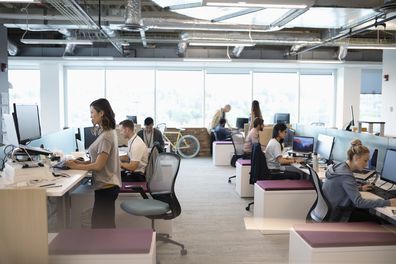'Abandon the traditional nine-to-five working day'
For many working Australians, the constant struggle to maintain a sensible work-life balance is tough. Throw 24/7 high productivity expectations into the mix and stress can become full-time feeling.
Dr Amantha Imber, an innovation psychologist, thinks she has a solution to the battle most workplaces face when it comes to building high performance teams, and it all centres around abandoning the traditional nine-to-five working day and ditching the mentality that has been a workplace norm for too long.
"Workplaces would do well to challenge the assumption that the best work gets done between the hours of 9am to 5pm, because the reality is it generally doesn't get done between those hours," says Dr Imber.
"Workplaces need to recognise that individuals run on different time clocks and rather than trying to force everyone into your time clock you're far better off adjusting your working hours to suit when your employees are going to be at their cognitive best."

Dr Imber is the founder of Inventium, Australia's leading innovation consultancy, she's also the best-selling author of "The Innovation Formula" and hosts the How I Work podcast, she knows a thing or two (or twenty) about running a successful team.
Three years ago, her Melbourne-based innovation consultancy firm announced they would be introducing an unlimited paid annual leave policy for all staff. It made headlines worldwide and, naturally, attracted skeptics. Most naysayers believed it was another way for employers to guilt their staff into working more but for Dr Imber the policy is a way for the business to commit to being truly flexible.
"It was really based on what I was observing in terms of people lacking a balance between their working and non-working life," she says.
"We typically work long hours; we travel a lot and it's an industry that doesn't pay overtime so what I was seeing was that essentially the hours were uncapped but the leave was capped at four weeks.
"So basically, uncapping leave seemed like a fairer way and a better way to manage things so that people could just be adults and take leave into their own hands and decide how much they need based on how hard they're working and their work load."
Three years in, Dr Imber reveals that staff take five and a half weeks paid annual leave a year (on average), their engagement scores are in the ninetieth percentile for their industry and sick leave is well below the Australian average of eight or nine days per year at two and a half days per person annually. Another added bonus is the average tenure has almost doubled since the policy was put in place.
But giving staff the option to holiday for as long as they desire isn't the only reason the company has seen success.
Staff are encouraged to work whenever they want, by working to their Chronotype.
According to Dr Imber, your Chronotype is basically your natural energy rhythms and sleep-wake cycle over the course of 24 hours. Everyone's is different. So, while you might work best in the morning, the person next to you might thrive closer to midnight and for this reason staff at Inventium are allowed to work when they are at their most energetic and focused.
There are 15 workers based in Inventium's head office, but pay a visit and you'll see only three to four there each weekday. For managers, this might sound counter-productive but, in fact, itĄŻ' the opposite.
"Staff are strongly encouraged to work from wherever they get their best work done, which for many means working from home where they can work uninterrupted," says Dr Imber.
"Others choose to work from caf¨Ś's where the white noise, but lack of interruptions from co-workers, creates the perfect focus-inducing environment. One worker has spent the last six months working part-time from a villa in Italy."
It's the dream right? Here's hoping it doesn't take long for this to become the workplace setup of the future.



